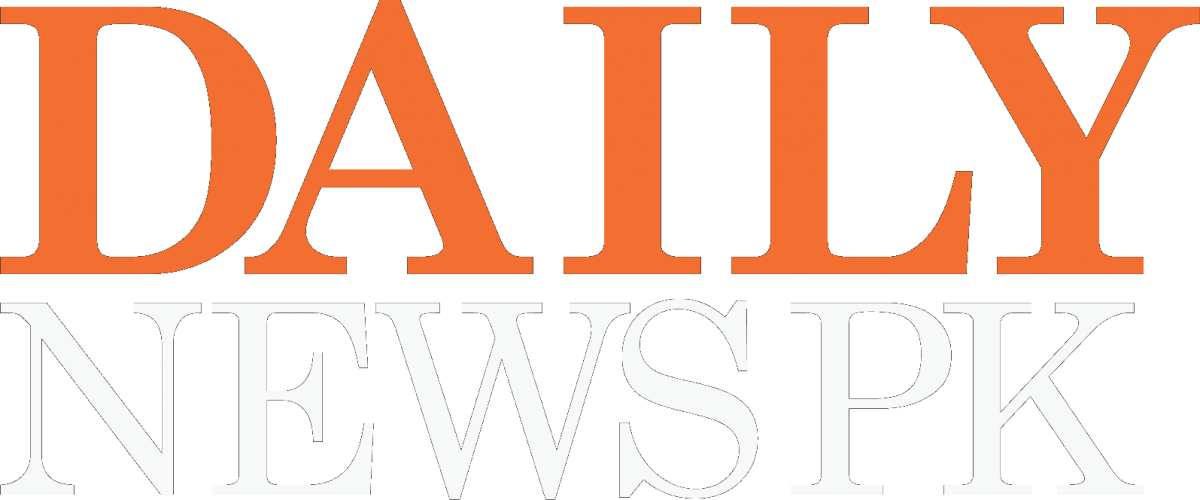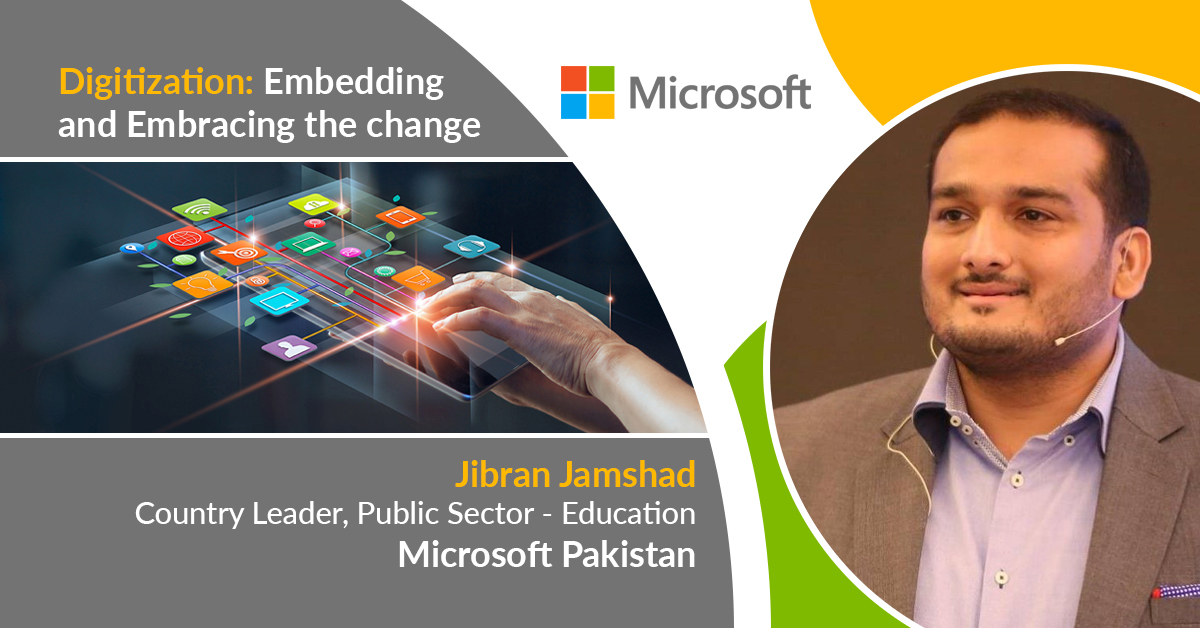Jibran Jamshad, Country Leader, Public Sector – Education at Microsoft Pakistan shares how they are increasing productivity and facilitating innovations by harnessing technologies to enable interactive, engaging and connected learning to revamp the education system for a digital future.
Jamshad says, “Technology is no longer an investment that’s nice to have, it is integral to ensuring long-term and sustainable economic growth.”
He further says, “By increasing productivity, improving inefficiencies, and facilitating innovation, technology is a key sector for the development of any economy. While Pakistan is implementing efforts to accelerate digital transformation in the country, it is still only at the beginning of its digitization journey.”
The impact of COVID-19 has really brought technology to the forefront and has showcased just how powerful technological solutions can be in helping to address complex socio-economic challenges. As Microsoft’s CEO, Satya Nadella mentioned, “We have seen two years of digital transformation in two months and here we’ve witnessed the stark differences in capabilities to handle obstacles brought on by the pandemic by those who have embarked on their digital transformation journeys and those who have not. I do believe that a lot of the concern around certain technologies have somewhat dissolved and there is a greater acceptability around technologies such as AI and the cloud after people have seen them in action within the current crisis.”
During his conversation with Daily NewsPK, Jibran Jamshad highlights how they are supporting Public and Private sector education institutions in Pakistan before and after the recent crisis. What is their vision for the future generation and what initiatives they have taken to realize them.
1. In terms of skills and knowledge, youth needs to compete in the job markets of today. What initiatives should be taken to address reskilling and up-skilling challenges and to equip them with right skills?
There is a lot of work that needs to be done to pivot the education system towards one that is highly conducive of digital skills learning for a digital future, not only in Pakistan but around the world. Employers need to stay ahead of skills trends and provide ways for their employees to easily upskill or reskill to suit the relevant environment or to fill skills gaps in organizations. Schools need to ensure digital literacy, and at a more advanced level, across all levels of schooling to ensure familiarity with technological tools and systems and build a foundation for more technically-skewed digital careers. We must also ensure accessibility of relevant skills for the job market. This means we must be able to guarantee that background, socio-economic status etc does not impact an individual’s ability to gain the skills needed to attract better opportunities and create a better life.
2. As demand for new digital skills is increasing, what offerings have been introduced from Microsoft to unlock the potential of new technologies in order to empower our younger generation?
Microsoft recently announced its Global Skilling Initiative to provide over 25 million job seekers with the relevant digital skills needed in 4IR and was created in direct response to the fallout of the COVID-19 pandemic which has resulted in the loss of many jobs and could result in more in the future. The initiative is meant to ensure inclusive economic recovery post-COVID-19 and beyond, but this is only its first phase. The second and third phases of the initiative will focus on providing employers with tools to help skill and upskill their employees and provide skilling partnerships and programs for students respectively.
3. How do you see the future of learning environment in educational institutes? Whom you are partnering with to digitalize educational sector in Pakistan?
Over the last few months, education systems have had to quickly adapt to a completely new way of learning. Educational institutions, educators, and students have shown incredible commitment, flexibility, and adaptability while responding to the need for remote learning.
During this shift, technology has played a critical role in enabling interactive, engaging and connected learning through the use of collaborative tools. These solutions have the ability to continue to create new efficiencies for educators while creating a more stimulating and involving learning environment for students. Because of this, I see hybrid learning, a mix between digital/remote and in-classroom education systems, as the future of the learning environment within educational institutions.
Disruption can bring instability yes, but it is also a catalyst for change. The challenges highlighted during the disruption should not come as a surprise. Over the last decade, student engagement has plummeted.
1 Students’ sense of hope has declined.
2 This disruption revealed systems that were seriously unprepared to support all learners. To put it plainly: it’s time to situate education as an instrument of individual and societal good.
4. How is Microsoft collaborating with educational institutions in order to equip them with remote learning capabilities?
During the early stages of the pandemic, as economies started to close off to curb the spread of the novel coronavirus, Microsoft announced that its collaboration tool, Teams, would be free to use to ensure business and education continuity, as well as foster communication during a time when we are apart from one another.
In addition, Microsoft integrated the platform with a number of popular learning management systems to enable educators to communicate effectively with students while presenting learning content such as coursework, assignments, and tests in much the same way as if they were in a physical classroom environment.
In partnership with New Pedagogies for Deep Learning, Microsoft developed a position paper on a paradigm shift for education (from remote learning to hybrid learning). The paper lays out three key phases to creating a strategy that builds a bridge to a reimagined education system.
Phase 1 focuses on disruption to identify the initial responses and lessons learned during such responses in the first months of the pandemic. Phase 2 looks at the transition, how to navigate planning for the reopening of schools, and Phase 3 speaks to reimagining the way we approach education drawing on traditional learning systems and innovative practices. The whitepaper serves as a guide to support educational institutions adapt to a new environment of learning.
5. As Pakistan is undergoing a nationwide digital transformation under “Digital Pakistan” How Microsoft is supporting the government?
To accelerate remote learning in a safe and secure environment, Microsoft is supporting the education ecosystem in Pakistan to reduce the disruption of learning in the country.
- The Higher Education Commission (HEC) of Pakistan by deploying Teams for official online and remote learning interactions across more than 100 public and private universities. The move is in response to the call by the HEC for ideas on how to address the impact of COVID-19 on education and research. This pandemic has forced educators and students to rush into distance learning. “Our strong collaboration with Microsoft has spanned many areas including research innovation, capacity building, and of course the services provided by Office 365. The use of Teams will ease the transition for many of our members into innovative modes of educational delivery, and also help us address the future needs of our students in rapidly shifting employment markets
- Microsoft is also working closely with School Education & Literacy Department and Sindh Education Foundation, Government of Sindh and we have supported them to conduct online classes using Microsoft Teams by enabling approximately 50,000 students & teachers and have also trained their staff to create 500+ master trainers
6. Ongoing crisis has accelerated digital transformation in businesses and education system. What changes do you expect to see during the next 12 months?
We are experiencing a time of instability and uncertainty. What’s true today might not be true tomorrow and therefore it is difficult to make any clear predictions around what the world will look like in a years’ time. However, we can be certain of a few things. Firstly, technology is crucial to an organization’s ability to adapt rapidly to change or disruption, thus it is highly likely that we will continue to see accelerated digitization across every industry and organization in the years to come. It is also clear that we cannot simply go back to the way things were. We must adapt to the new normal and create new ways of doing business and providing education.
So, what does quality learning look like in the hybrid environment? Technology will be prominent in the service of the twin humanity pillars of well-being-and learning. In turn, well-being (mental and physical) and its associated relationships will be foundational to learning. Learning itself will cultivate and build on the sense of purpose of children and youth to contribute to a better world for themselves and others. Learners will be drawn to the global competencies such as the 6Cs, which will guide learning and encompass the basic skills of literacy and numeracy. The other disciplines will flourish as sources of human expression, creativity, exploration and development. Learning will become ubiquitous—any place any time. There will be a mix of individual, small group, and whole class engagement. Student led activities, expert engagement, and a blend of real-life and online learning will concur. Learning will happen at school, at home, in the community and beyond. Assessment of learning will change where the relative roles of artificial intelligence and human judgment will become clarified in terms of grading, commentary and feedback to enhance engagement and learning. Some extremely disadvantaged students initially will need specific support; the majority will become readily engaged in this new system. The neuroscience of new learning confirms the endless potential for better learning for everyone.












It is great that you have the support of a giant like Microsoft to ensure business and education continuity. What I feel is that with the three phases, you guys should be able to slowly navigate towards opening of schools later on this year. With Microsoft’s help, you can easily overcome the hurdles that you will initially face when you reboot the conventional system of education.
Nice post. I was checkikng continuoussly this blog aand I amm impressed!
Veryy usefull information speciallyy the last part 🙂 I care foor such imfo much.
I waas seekinhg this certyain invo ffor a lon time.
Tank you and gookd luck.